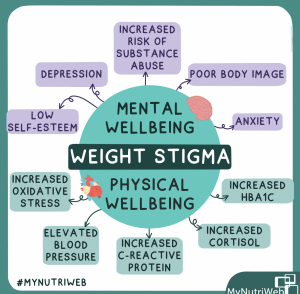This document provides three definitions (parenthetical, sentence, and expanded) of the term Weight Stigma. This term is in my previous degree Nursing. The purpose of this activity is to practice the skill of explaining a complicated and technical subject to an audience with no prior understanding of the subject.
Term: Weight stigma
Situation: A definition in Psychological Nursing Book for a first-year Nursing course.
Audience: First-year Nursing students and other readers of these book. They can understand general English but have limited knowledge about Nursing Psychology.
Parenthetical Definition: Weight stigma (also known as weight bias, size discrimination, or fat phobia) refers to negative attitudes, beliefs, and actions directed towards individuals based on their weight or body size, regardless of their actual health status.
Sentence Definition: Weight stigma refers to negative attitudes and beliefs towards individuals who are overweight or obese, often resulting in discrimination and bias. Weight Stigma can include stereotypes, prejudice, discrimination, and harassment, and can have negative impacts on an individual’s mental and physical health, self-esteem, and overall well-being.
Expanded Definition:
Examples of weight stigma can include being passed over for a job or promotion, receiving negative comments about one’s body size or shape, being denied access to certain medical treatments, or facing social exclusion(Palmeira et al,. 2018).
Weight stigma can have serious consequences for an individual’s mental and physical health. Research has shown that experiencing weight stigma can lead to increased stress and anxiety, which can contribute to further weight gain and a range of negative health outcomes. Additionally, weight stigma can result in body dissatisfaction and low self-esteem, which can lead to negative body image and disordered eating(Puhl et al,. 2009).
Weight stigma is a complex issue that is influenced by a variety of factors, including cultural beliefs about beauty and body size, historical attitudes towards weight, and the media’s portrayal of ideal body types. Despite increasing awareness about the negative impact of weight stigma, it remains a pervasive problem in many societies, and it is important for individuals to actively challenge and counteract these harmful attitudes(Pearl et al,. 2018).
Weight Stigma is divided into three categories according to the type of discrimination: ①Experienced weight-stigma, individuals are subjected to discrimination from the outside world against themselves for being overweight or obese. ② Perceived weight-stigma, overweight or obese individuals perceive this unfriendly treatment or discriminatory behavior from different sources (such as work colleagues, strangers) and recognize that this behavior stems from on own body weight. ③ Internalized weight stigma (self weight-stigma), individuals who are overweight or obese accept this stigma and devalue themselves(Alimoradi et al,. 2020)

References:
Palmeira, L., Cunha, M., & Pinto-Gouveia, J. (2018). The weight of weight self-stigma in unhealthy eating behaviours: The mediator role of weight-related experiential avoidance. Eating and Weight Disorders – Studies on Anorexia, Bulimia and Obesity, 23(6), 785–796.
Puhl, R. M., & Heuer, C. A. (2009). The stigma of obesity: A review and update. Obesity, 17(5), 941–964.
Pearl, R. L., & Puhl, R. M. (2018). Weight bias internalization and health: A systematic review. Obesity Reviews: An Official Journal of the International Association for the Study of Obesity, 19(8), 1141–1163.
Alimoradi, Z., Golboni, F., Griffiths, M. D., & others. (2020). Weight-related stigma and psychological distress: A systematic review and meta-analysis. Clinical Nutrition, 39(7), 2001–2013.
Leave a Reply